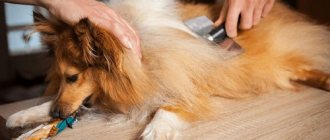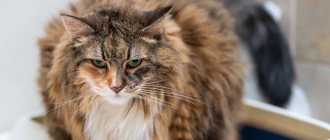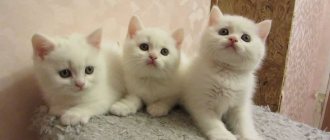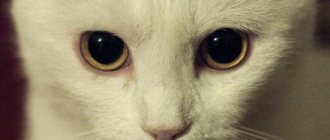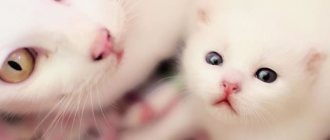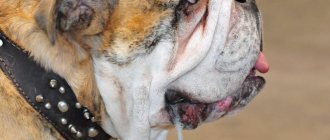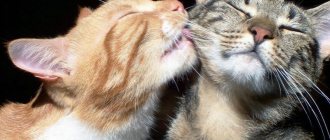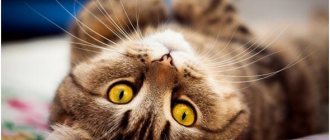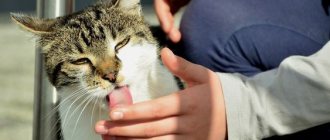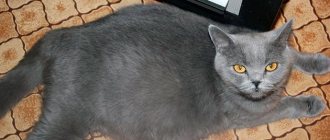Shedding in a cat is one of the most important problems that a person who does not know the characteristics of the cat’s body, character, cat breed, etc. may encounter.
You don't always need to sound the alarm when you notice that your cat has begun to shed heavily.
In this article we will consider such important issues as:
- What is the molting process?
- Why does a cat shed? (causes)
- Kittens' first molt
- Shedding periods in adult cats
- What to do if your cat sheds a lot? (medicines and grooming)
- Anti-shedding food
- What cat breeds don't shed?
- How we deal with our cat's shedding (advice from experienced people)
What is the molting process?
Shedding in cats
- This is a natural or forced process of hair loss, in which the animal’s body completely or partially loses its coat. Depending on the breed, age and reasons for shedding, this process can be either intense or subtle. Most cats shed in the spring and fall, but under certain conditions they shed throughout the year. In healthy animals, the end of shedding occurs when the old hair is completely replaced by a new, shorter or longer one.
AGE OF THE KITTEN AND ITS CHARACTERISTICS
The development of kittens occurs quite intensively in the first months of life; their structure and nutrition undergo many changes. And this time of growth of a kitten is considered the most important in its development and formation, so you need to do everything correctly and, most importantly, on time!
The article contains a lot of useful information: up to what age does the growth of a cat and the growth of cats continue, the size of the cat and what size the cat will be in each month of its life, the development of a kitten by month: stages of kitten development (kitten development calendar), the growth of kittens by week, weight kittens by month, the behavior of kittens in each period of development, how to raise a kitten so that it grows up social, when kittens open their eyes and much, much more.
The development of a cat and the development of a cat are slightly different; a cat does not gain weight as rapidly, however, as a rule, cats are more curious and active than males. But in general, everything happens at the same time, without serious lags on both sides. The development and growth of kittens by month in the table will help determine the age of your pet!
Why does a cat shed? (causes)
There may be several reasons for a cat to start shedding:
- seasonal shedding,
- sudden change in ambient temperature,
- diseases,
- stress,
- power replacement.
During seasonal molting,
when a cat’s coat becomes either lighter, or, “on the contrary,” thicker and warmer, there should be no reason for concern. This is a natural process, because our pets, anyway, are descendants of wild cats and are naturally supposed to react to warming or cooling. Unfortunately, any shedding is accompanied by the loss of a large amount of hair and, depending on what breed of cat you have, you will have to temporarily put up with some inconveniences associated with daily cleaning of the apartment or cleaning clothes from stuck cat hairs.
Sometimes, nature gives us “surprises” in the form of abnormally low or unusually high temperatures at a completely inappropriate time of year. For example, at the end of spring there may be a sharp cooling, or in the middle of autumn it may become very warm, down to summer levels. In such cases, the cat’s “internal clock” begins to go astray, and she rushes to acquire a coat of a suitable style. When the temperature anomaly ends, the animal sheds its “wrong” coat and the process of fouling with the appropriate coat begins again.
Health problems
, can also cause
molting
. It is important to know that some cat breeds (Maine Coons, British, Siberian) shed constantly and this is their normal condition. If your animal does not belong to the above breeds, but its fur literally comes out in clumps, then this may be a consequence of some disease. Most likely, these may be certain hormonal disorders or problems in the gastrointestinal system. This can be determined by the appearance of characteristic bald patches on the cat’s body, as well as by redness or itching on its skin.
Stress
– this is another factor that can lead to intense and untimely molting. Perhaps we often do not pay attention to the psychological state of our furry pets, but cats, nevertheless, are very impressionable and vulnerable creatures.
Often cats shed as a result of severe fright or prolonged nervous tension.
Even a change in the interior decor of the apartment can cause shedding, since cats are quite conservative in this matter. If an animal is very strongly attached to its owner, and he is absent for a long time, then the cat experiences great stress and may, as a protest, “decide” to have an unplanned molt.
Changing cat food
greatly affects the functioning of the animal’s gastrointestinal tract, can cause allergic reactions and, as a result, causes intense molting. If your “ward” suddenly starts to grow fur, then this is a sure sign that his body is rejecting the new menu. Immediately stop feeding your cat the new food and return to the food the cat was eating before. Menu variety is not always good. Cats don't have the same need for a variety of foods as people do. In nature, they generally try to adhere to a specific diet and give preference only to those products that they “trust.”
Causes and signs of pathological molting
How can you tell if shedding is a symptom of a disease and not a seasonal natural process? Signs of pathological hair loss:
- cover change lasts longer than 2 months;
- in place of the fallen hair, bald spots remain that do not heal for a long time;
- redness, rash, ulcers appear on the skin;
- the animal’s behavior changes: it becomes nervous, irritable or, conversely, lethargic, and loses appetite.
What can cause the pathology:
- Hormonal disbalance. Endocrinological diseases, the inability to reproduce in non-castrated animals - all this can affect the condition of a pet’s coat.
- Stress. A change of environment, moving, severe fright - all this can cause hair loss. Some animals are calm about changes in external circumstances, while other cats become nervous even when a stranger comes into the apartment and tries to pet them.
- Poor nutrition. Nutrition has a significant impact on a cat's condition. The food must be balanced and contain the required amount of vitamins, macro- and microelements. If the owners give their pet food from their table or feed them cheap food, then its fur may become dull, lose its natural shine and begin to fall out.
- Allergy. One of the symptoms of allergic dermatitis is hair loss. The disease is also accompanied by itching, the cat scratches the sore spot, and non-healing wounds form on the skin. Allergies can be caused by household chemicals, medications, and food.
- Infection with parasites and fungus. The hair begins to fall out in patches, and large bald spots form. The skin itches, a rash appears, and festering ulcers appear. The animal should be taken to the veterinarian immediately, because such infections are dangerous for people and lead to serious consequences for the cat’s health.
Kittens' first molt
Kittens have their first moult
is accompanied by the replacement of undyed hairs with the hair of adult animals and
occurs
, most often,
at the age of 5-7 months, in spring or autumn
. When purchasing kittens, you should understand that their color will likely change. Shedding starts from the head and gradually continues throughout the kitten's body. The animal's head will receive its permanent color before other parts of the body, and the rest of the body can molt for a whole year or even more.
When do kittens change fur and eye color?
In the first year of life, a kitten not only adapts to its environment, grows, learns, plays, but also changes the color of its eyes and fur. Just as baby teeth fall out and give way to permanent teeth, the original color and color of the eyes change over time to adult ones. We will tell you at what age it is possible to determine the color of kittens and the color of their eyes, and when the kitten’s owners should expect the beginning of such changes in the pet’s appearance.
Changing eye color
For a newborn kitten, vision does not play a significant role. Babies open their eyes between one week and 16 days. Only in the third week of life do they begin to see. Until four weeks of age, a kitten's eyes are covered with a protective film; it disappears on its own when the time comes. Small kittens usually have blue or blue-gray eyes. This is due to the fact that almost all the pigments went to forming the fur color; they have not yet really reached the eyes. In one month, when the kittens' eye color changes, it becomes noticeable that splashes of a different color have appeared in the sky-blue iris.
The less pigment, the lighter and cooler the eye shade. At the time of birth, there is still very little pigment in the iris. For this reason, all babies have cool blue or light blue eyes.
The process of changing the color of a kitten's eyes is called pre-blooming. If you want a pet with a certain eye color, choose a baby around four months old. By this point, the kitten’s eye color has changed so much that one can conclude what it will be like throughout its life. With a 50% chance you can guess what your pet's eyes will be like by looking at the eye color of its parents. Some changes in eye color are possible before the age of two. Green eye color takes longer to form than others.
What to do if your cat sheds a lot? (medicines and grooming)
To reduce the negative effect of cat shedding, it can be “optimized.” Thus, there are a number of special medications that not only stop the process of heavy shedding, but also stimulate the formation of healthy hair in cats.
Neo
Omega
has proven itself well that promote the growth of healthy hair, containing Omega-3 substances and antioxidants.
In addition, there is a drug
Shed- Pro
, which stops intense shedding and removes the fur that has gotten there from the cat’s stomach.
Omegaderm
eliminates skin itching, restores the animal's skin and maintains the coat in proper condition.
Alloderm
Spot On
are drops for external use that quickly restore damaged epidermis and also significantly speed up the process of shedding.
Grooming (haircut)
Cat grooming is one of the effective ways to alleviate the possible consequences of shedding. Firstly, you will not need to constantly comb your cat and remove clumps of its fallen fur, and, secondly, you will prevent the cat from swallowing its own hair when licking, and thereby reduce the risk of obstruction of its intestinal tract.
How to reduce the consequences of frequent and prolonged shedding of a domestic cat?
The seasonal molting period creates problems for animal owners. To minimize troubles, you need to:
- Brush your pet regularly. There are special combs and mittens for this. Particular attention should be paid to long-haired pets - without proper care, they look untidy and develop tangles. Thanks to frequent brushing, there are fewer hairballs left on the floor and clothes are less dirty.
- Reduce the periods between baths. If in normal times it is enough to bathe a cat once every 3-4 months, then during shedding you should wash your pet at least once. This will help get rid of dead hairs.
- Enrich the animal's diet with vitamins and minerals. During the period of coat change, the cat needs a complete, balanced diet; a lack of vitamins B, A, and E will negatively affect the condition of the coat.
If you suspect that hair loss is associated with an animal disease, you should immediately visit a veterinarian. Only a doctor can correctly determine the cause of pathological molting and prescribe treatment.
Source
How to relieve a cat's condition
Hypotrichosis is incurable. The animal will constantly freeze. Therefore, it is necessary to maintain an optimal air temperature in the apartment - 22-24 °C. If the owners decide to walk the cat in cool weather, they will have to dress it.
Long-haired pets are periodically combed.
In long-haired pets, in addition to excessive shedding, intestinal blockage may occur with trichobezoars - stones formed from a mixture of hairs swallowed while licking and the contents of the alimentary tract.
If the cat owner does not use special super-premium food, you will have to periodically give Malt paste, which prevents hair from clumping.
To speed up molting, special feed additives are used:
- Laveta Super from Beafar;
- Sherstevit;
- Gimpet.
Products based on brewer's or feed yeast reduce the duration of shedding. Caring for a shedding pet involves frequently combing out lost hair.
In advanced situations, the crumpled wool is removed using tangle cutters. If the cause of hair loss is a contagious disease, you must follow the instructions of your veterinarian.
Why is it important to remove dead hair?
Villi that have already fallen out but are not removed from the cat’s body can cause irritation and itching on the animal’s skin. It actively licks off excess fur and tries to remove it with its paws.
This can be dangerous because when hairballs get into the stomach, gastrointestinal upset and intestinal obstruction begin.
Hair getting into the stomach leads to intestinal disorders and causes nausea
With its paws, a cat can scratch itself, which serves as a breeding ground for infections that cause skin diseases.
Wool flying around the house can cause allergies in allergy sufferers living in the house, especially in the spring.
SEE THE STAGES OF KITTEN DEVELOPMENT IN THE KITTEN GROWTH TABLE
Let's consider all stages of development of kittens from birth to one year, their characteristics of maturation and growth, features of care at each age.
A newborn kitten is born weighing 80-120 grams, the size of kittens at birth is body length about 9-12 cm.
Very rarely, but still there are cases of the birth of kittens 50-70g, they are small but active. This does not always serve as a signal that the kitten is sick or has abnormalities. This also occurs in multiple pregnancies or in the case of small parents.
Newborn kittens: photo of the litter Newborn kittens are absolutely helpless during this period, they are blind, deaf, and do not know how to regulate their temperature. Newborn kittens have no undercoat; the fur is thin, weak and does not warm at all.
Newborn British kittens Kittens do not know how to stand on their paws, their bones are very fragile, so babies require special care. At this time, sleep and kittens are almost inseparable concepts. Newborn kittens sleep almost constantly and eat a lot and often. Kittens need sleep for the further development of their nervous system. Newborn kittens also cannot defecate on their own; the mother cat licks their genitals and eats their feces. What is really well developed in newborn kittens is their sense of smell and touch; they easily find their mother’s nipples, fingering them with their paws, sucking and, thereby, stimulating further milk production.
Newborn kittens: photo of the litter During this period, it is better not to touch the kittens at all, just monitor their weight. Kittens should add it daily (about 10-20 grams per day), if the kitten is growing, then everything is in order.
Things to take care of:
- Set up a box for a cat (or organize a maternity house) with newborn kittens. It should be warm and dry there. The bedding should be changed (it is advisable to use white sheets to track the color of the mother cat’s discharge), because The cat will have postpartum discharge. Also, if necessary, you can put a heating pad.
- Cat food. It should be plentiful and balanced; food is a must for nursing cats. Food and water should be freely available, next to the nest box. It is also recommended to place a tray here.
Cats are by nature excellent mothers and may not leave the box for a whole week, so it is important that newborn kittens have enough milk. In the first days, the cat produces colostrum (very fatty, nutritious milk that has antibodies, thanks to which kittens develop lasting immunity).
If there are a lot of kittens, be sure to make sure that each newborn kitten gets its good portion.
The development of kittens after birth (the development of newborn kittens) is very active, so the first week can be planned out day by day.
UNTIL WHAT AGE WILL KITTENS REMAIN BABIES? HOW MANY MONTHS WILL THE KITTEN BE A KITTEN?
Determining the age of a kitten: if you want to determine the age of a kitten based on external data and characteristics, carefully study the table and find the characteristics that match your pet. Determining how many months a kitten is is quite simple, because a kitten changes a lot every month. Here are the characteristics that you should pay attention to to find out how many months a kitten is: weight and size of kittens by month, teeth (baby, permanent, or during the period of teeth change), fur and undercoat, eye color, behavior. So how do you find out the age of a kitten? Read the description in the table and compare!
Also, how to find out how many months a kitten is and how to determine the age of a kitten will be helped by a photo.
